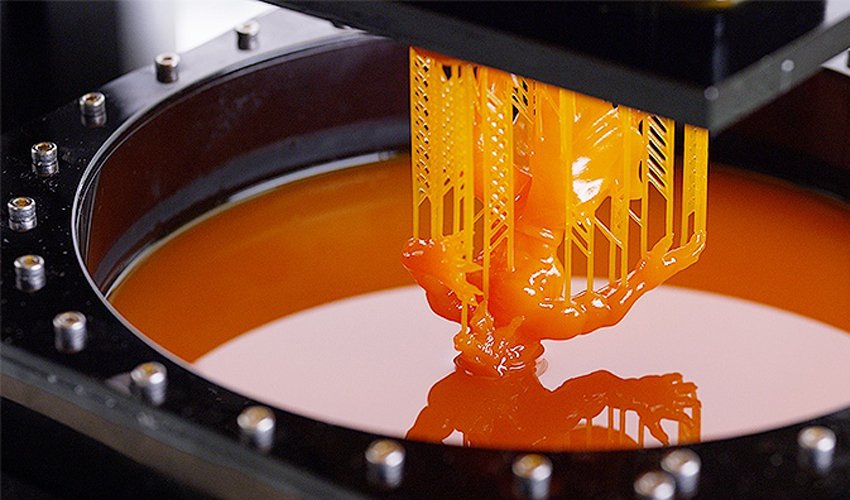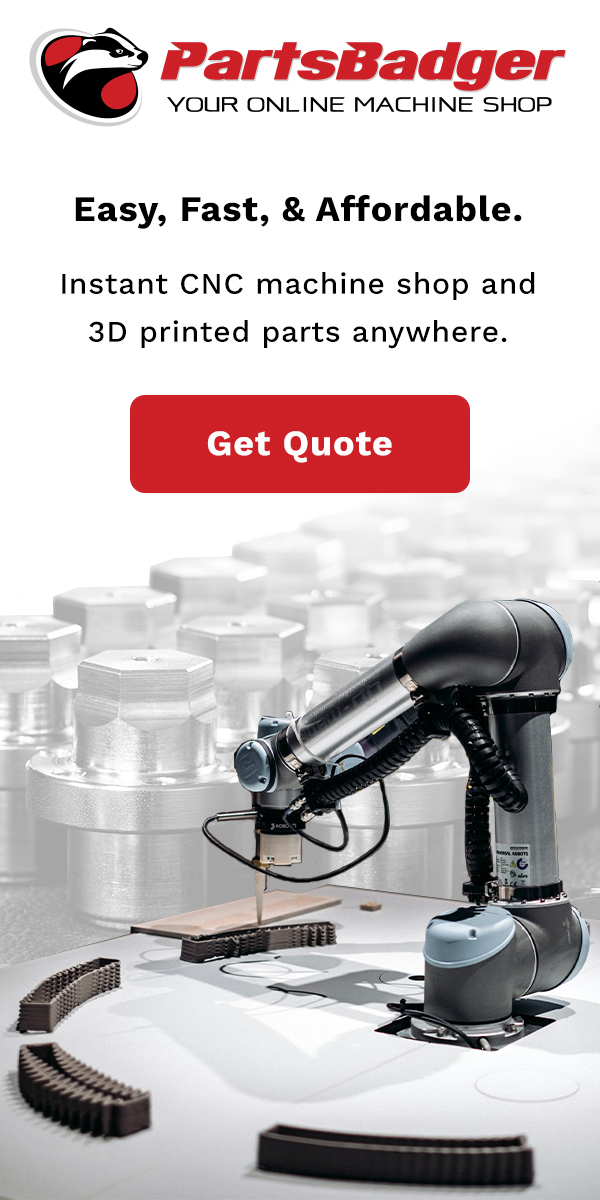What is an SLA 3D Printer?
An SLA (Stereolithography) 3D printer is a tool that creates rapid prototypes through photopolymer resin. 3D Printing is an additive manufacturing process, which is the complete opposite of a subtractive process.
While subtractive manufacturing processes like laser cutting and metal bending take away from metal to create parts, additive manufacturing builds parts from a 2D model. Unlike Fused Depositional Modeling printing, which uses filaments to create 3D objects, SLA uses resin instead.
Originally known as rapid prototyping, 3D printing is the process of building 3D solid objects from a digital file. G-code is the most common file format. This file contains coordinates to guide the printer’s movements to print the material. These coordinates guide the printer’s movements, both horizontally and vertically, through the x, y, and z axes. 3D printer resolution separates into two different segments: Z resolution (vertical) and XY resolution (horizontal).
XY resolution is a combination of the laser’s spot size and the increments by which the laser beam can be controlled. For example, the Form 3 LFS 3D printer features a laser with an 85 micron spot size, but because of the constant line scanning process, the laser can move in smaller increments and the printer can consistently deliver parts with 25 micron XY resolution.
That is just the beginning process of creating a 3 dimensional object through SLA. There is so much more to the rapid prototyping process.
How the SLA 3D Printer Works
The SLA 3D printer acts much differently than an FDM 3D printer. Unlike FDM printers that use filaments like thermoplastics to print the product from the base to the top, SLA dips the product upside down into the thermoset resin. The printer uses a laser at the bottom of the dish of resin. This light source uses G-Code from the 3D file to coordinate the exact position to permanently cure the resin one layer at a time.
Since it uses SLA to build layers, it takes a period of hours to turn 2D prints of a 3D CAD drawing into a three dimensional object. The 3D printer must dip over the same area of the resin bath in order to create all the necessary details for layering. SLA 3D printers have the highest resolution and accuracy, the sharpest details, and the smoothest surface finishes of all 3D printing technologies. Unlike thermoplastics, thermosets permanently mold after heating.
According to WoodlandPlastics.com, a thermoset monomer must have three or more reactive ends, with its molecular chains crosslinking in three dimensions. Post-molding, thermosets have virtually all molecules interconnected with strong, permanent, physical bonds which are not heat reversible. The SLA 3D printer uses laser UV light to meticulously hit every exact detail of the build.

Post-Processing
Once the object completely prints, it must go through a post-processing. The process can vary depending on the project. SLA printers require much more than FDM printers. They need to wash with a specific type of liquid, isopropyl alcohol (IPA) or tripropylene glycol monomethyl ether. This will help avoid the products from being sticky. The machinist can remove the structures after the product is clean.
The machinists use Ultraviolet curing (commonly known as UV curing) to dry the coatings. Ultraviolet curing is a photochemical process in which high-intensity ultraviolet light is used to instantly cure or “dry” inks, coatings or adhesives.
This creates a very smooth finish that has high quality measurements. These SLA parts have very high dimensional accuracy and intricate details.
SLA 3D Printer Thermoset
SLA printers can use many different resins which are thermosets. These are the different types of resins.
- Standard Resin
- Clear Resin
- Tough Resin
- Flexible Resin
- Water-Washable Resin
- Ceramic-Filled Resin
Standard Resin
Standard Resin is the most popular liquid resin used for 3D printing. One of the major reasons for its widespread use is its high quality and affordable pricing.
We recommend using this yellow resin for beginners who are just starting out with resin 3D printing. This type of resin makes high-resolution printing of resin.
The following are the main properties of Standard Resin:
- Smooth surface quality
- Highly detailed features and remarkable quality
- Very affordable
- Can break with little effort
- Minimal impact resistance
- Not suitable for functional parts
- Comes in the largest range of colors
Standard resin is suitable for visual models with limited functionality, but with a high level of detail. Applications range from visual models to model trains and figurines.
Clear Resin
Clear Resin is another popular choice for those wishing to make transparent 3D prints. It’s in the same category as Standard Resin, but due to unique clear color, it deserves its own category. Many resins come in clear colors such as clear red, clear green, clear blue, or just clear.
The following are the main properties of Clear Resin:
- High-quality surface finish
- Makes transparent prints
- Water-resistant
- The clarity may degrade with time as the model is exposed to UV rays
The issue with clear resin is that It is really pretty tricky to work with. It must be mixed extremely thoroughly and it dries extremely quickly, so you have to work quickly. It can be difficult to apply smoothly and evenly.
Tough Resin
Tough Resin is the perfect choice when it comes down to producing strong, functional resin 3D prints that can easily handle stress and strain. It’s also called ABS-like since it resembles the mechanical properties of ABS.
Acrylonitrile Butadiene Styrene (ABS) is an opaque thermoplastic and amorphous polymer. ABS melts and becomes liquid at 221 degrees Fahrenheit. Once they heat up, they can cool down and reheat again. Since this is a thermoset, it will not be able to reheat again.
This material is ideal for making mechanical parts like machine assembly components, wearable items, and other objects that need to withstand wear and tear.
The following are the main properties of Tough Resin:
- High impact and shatter-resistance
- Durable and sturdy
- Best for creating sturdy functional parts
- Not recommended for models with thin walls
- Print removal can be a little difficult compared to Standard Resin
Tough resin’s drawbacks include a low heat deflection temperature. When comparing to other resins, SLA tough’s parts are relatively brittle compared to other plastics. Beyond that, SLA resins can limit product teams in terms of design. They’re ill-suited for parts with thin walls and finished parts may be difficult to remove from the build platform.
Flexible Resin
Flexible Resin is a unique material that boasts rubber-like properties. It allows users to create firm parts with a high degree of flexibility, although the latter does depend on the specific Shore Hardness value of the resin.
It can withstand bends and compressions easily and is perfect for making packaging materials, handles, grips, gaskets, and stamps.
The following are the main properties of Flexible Resin:
- Very flexible
- Great impact resistance
- Ideal for making flexible parts
- Can be hard to print with
- Mostly requires a good use of support structures
- Like Tough Resin, it’s also not recommended for models with thin walls
When comparing to other resin, Flexible Resin is very thick. This causes the resin tank to takes longer to fill with this than other resins. Due to its flexibility, the material flexes during the peel process, hence, the difficulty in printing tall and thin parts or features.
Water-Washable Resin
Water-Washable Resin is exactly what the name says it is. This material stands out for simple and easy post-processing with water instead of using IPA (Isopropyl Alcohol) or anything similar.
Apart from its ease of use, this resin boasts a low odor and higher strength than Standard Resin. However, it’s quite brittle as well, thanks to the gradual water absorption by the part as you clean and post-process it with water.
The following are the main properties of Water-Washable Resin:
- Effortless post-processing with water instead of alcohol or other solutions
- Appreciable strength
- Fast curing speeds
- Good detail
- Can be dyed or painted easily
- Absorption of water in parts can generally make them crack
- Affordable
An important disadvantage is that the liquid resin is water soluble. Making the printed part also sensitive to water and most likely not able to use in a wet or highly moist environment.
Ceramic-Filled Resin
Ceramic-Filled Resins are a sizable step up from Tough Resins. As the name depicts, this material is usually reinforced with ceramic materials resulting in extremely stiff, and smooth parts.
This type of resin also has great heat resistance and remarkable thermal stability, so you can make highly functional parts that can easily tolerate multiple rough conditions.
The following are the main properties of Ceramic-Filled Resin:
- Very tough and stiff
- Excellent for making fine-featured parts
- Highly resistant to heat
- Ideal for molds, jewelry, automotive applications, pipes, and manifolds
- Below-average impact strength
- Brittle
The fact that it is brittle means that it will wear down easier. This is a disadvantage for all SLA 3D objects. Now it is time to look into the benefits.
6 SLA 3D Printer’s Benefits
To review, SLA 3D printers have these benefits:
- Smooth surface finish
- short print time
- Efficient
- Variety of material choices
- Cost Effective
- User Friendly
Our SLA 3D printing service will get your parts printed in break-neck speed. Click here to request a quote for your next 3D printing job.
About PartsBadger
From prototyping to manufacturing, let PartsBadger take care of your manufacturing needs.
We’re here to help answer any questions you might have about our manufacturing techniques to get your custom parts made.
PartsBadger has state-of-the-art equipment like computer numerical control (CNC) mills, CNC lathes, laser cutters, water jet machines, die cast machines, sheet metal bending machines, 3D Printing, and more. This is the company that will give you the exact custom parts you need.
Contact us today for your quote or to find out more about our services.



Recent Comments